Case Study: Analyzing Monetary Policy & Economic Trends in Australia
VerifiedAdded on 2023/06/15
|22
|4249
|251
Case Study
AI Summary
This case study delves into the Australian economy, focusing on the Reserve Bank of Australia's (RBA) monetary policy decisions, particularly the cash rate. It examines the objectives of monetary policy, including price stability, exchange rate stability, and economic growth. The study also outlines the functions of money and the RBA, as well as Australia's economic relationships with China, Japan, India, and the USA. It analyzes the rationale behind setting the cash rate at 1.50 percent, the equilibrium in the money market, and the monetary transmission mechanism. The performance of key economic indicators such as GDP growth, inflation, unemployment, government budgets, and the housing market are assessed. Finally, the case study discusses economic growth, determinants of long-term growth, and sustainable growth strategies for Australia.
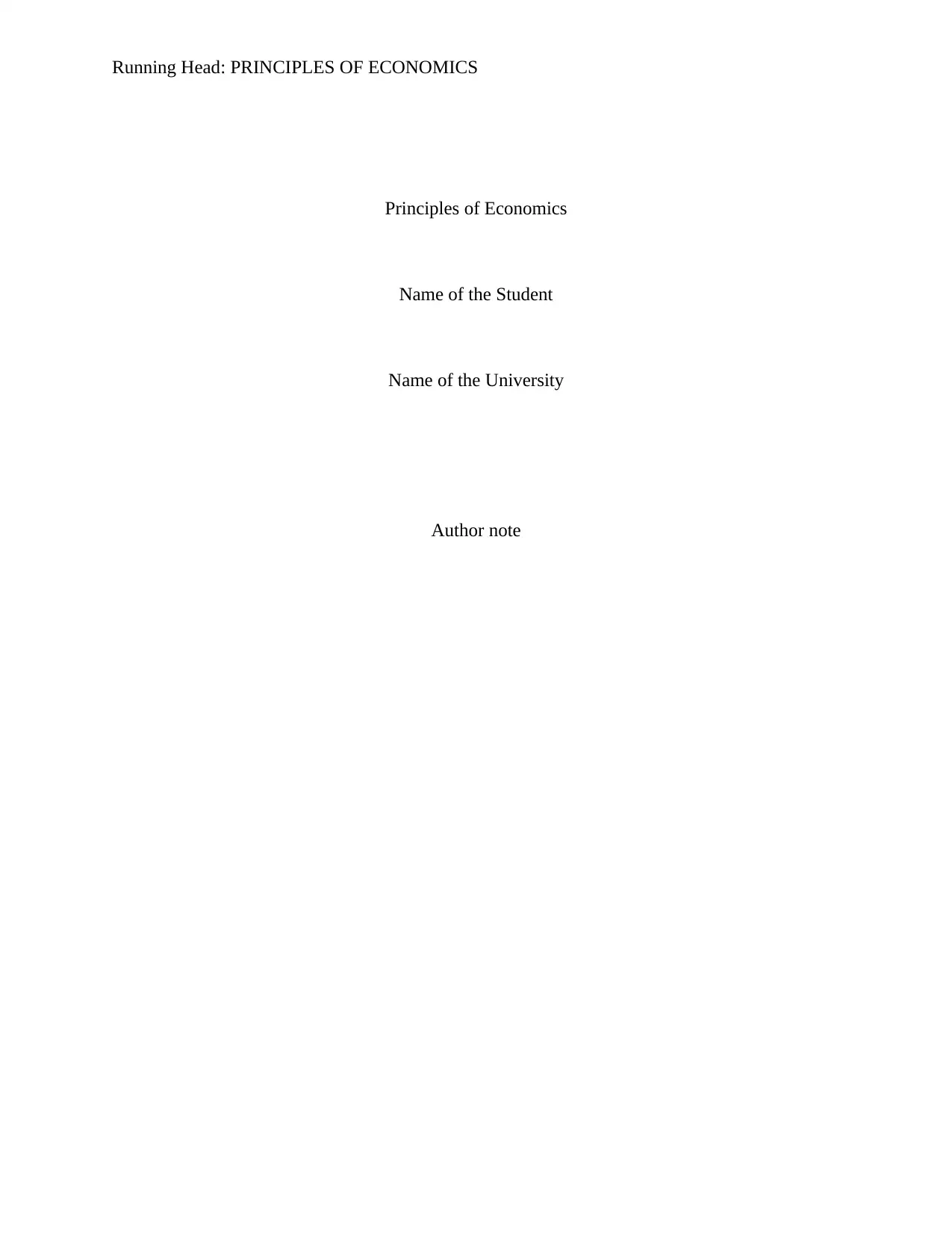
Running Head: PRINCIPLES OF ECONOMICS
Principles of Economics
Name of the Student
Name of the University
Author note
Principles of Economics
Name of the Student
Name of the University
Author note
Paraphrase This Document
Need a fresh take? Get an instant paraphrase of this document with our AI Paraphraser
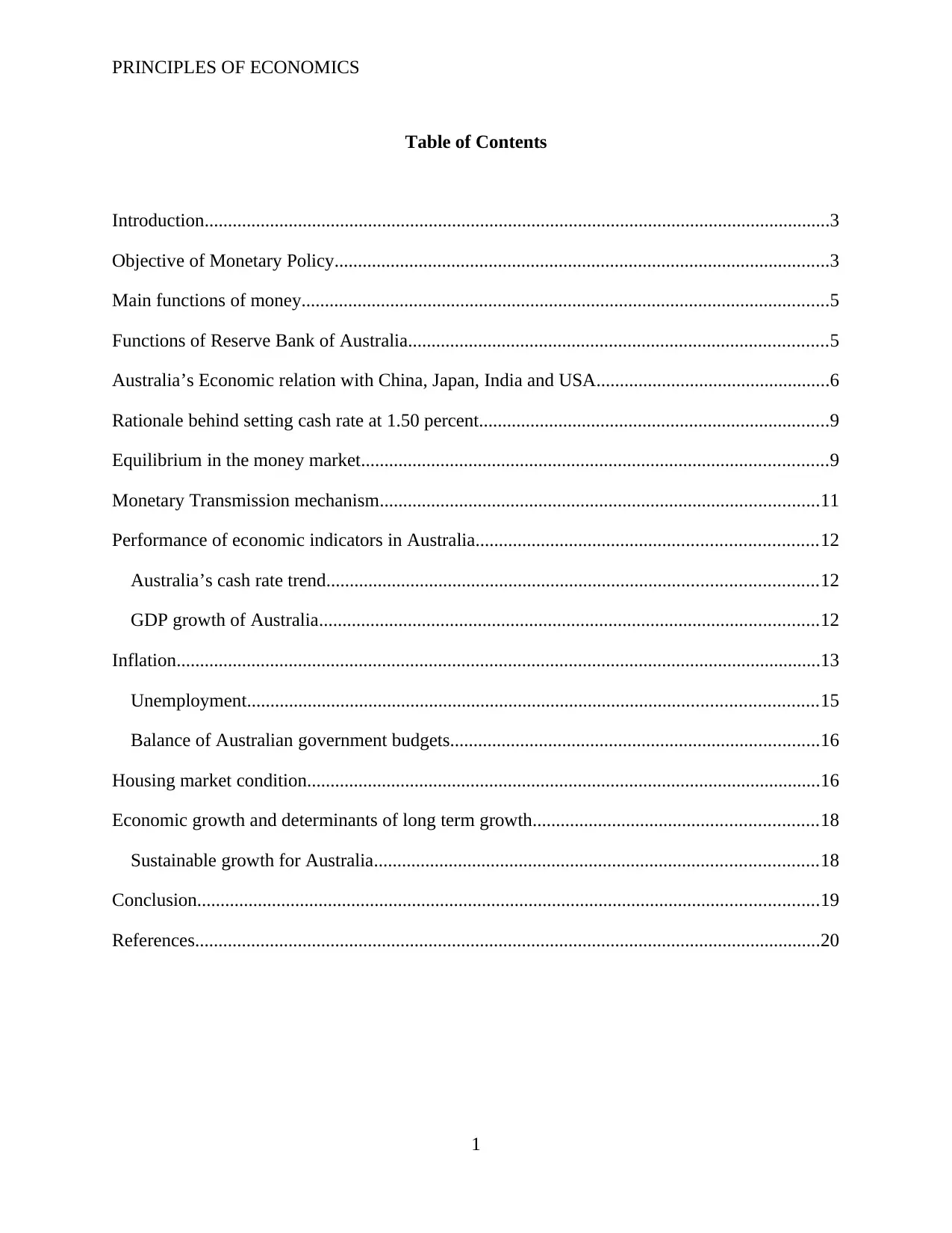
PRINCIPLES OF ECONOMICS
Table of Contents
Introduction......................................................................................................................................3
Objective of Monetary Policy..........................................................................................................3
Main functions of money.................................................................................................................5
Functions of Reserve Bank of Australia..........................................................................................5
Australia’s Economic relation with China, Japan, India and USA..................................................6
Rationale behind setting cash rate at 1.50 percent...........................................................................9
Equilibrium in the money market....................................................................................................9
Monetary Transmission mechanism..............................................................................................11
Performance of economic indicators in Australia.........................................................................12
Australia’s cash rate trend.........................................................................................................12
GDP growth of Australia...........................................................................................................12
Inflation..........................................................................................................................................13
Unemployment..........................................................................................................................15
Balance of Australian government budgets...............................................................................16
Housing market condition..............................................................................................................16
Economic growth and determinants of long term growth.............................................................18
Sustainable growth for Australia...............................................................................................18
Conclusion.....................................................................................................................................19
References......................................................................................................................................20
1
Table of Contents
Introduction......................................................................................................................................3
Objective of Monetary Policy..........................................................................................................3
Main functions of money.................................................................................................................5
Functions of Reserve Bank of Australia..........................................................................................5
Australia’s Economic relation with China, Japan, India and USA..................................................6
Rationale behind setting cash rate at 1.50 percent...........................................................................9
Equilibrium in the money market....................................................................................................9
Monetary Transmission mechanism..............................................................................................11
Performance of economic indicators in Australia.........................................................................12
Australia’s cash rate trend.........................................................................................................12
GDP growth of Australia...........................................................................................................12
Inflation..........................................................................................................................................13
Unemployment..........................................................................................................................15
Balance of Australian government budgets...............................................................................16
Housing market condition..............................................................................................................16
Economic growth and determinants of long term growth.............................................................18
Sustainable growth for Australia...............................................................................................18
Conclusion.....................................................................................................................................19
References......................................................................................................................................20
1
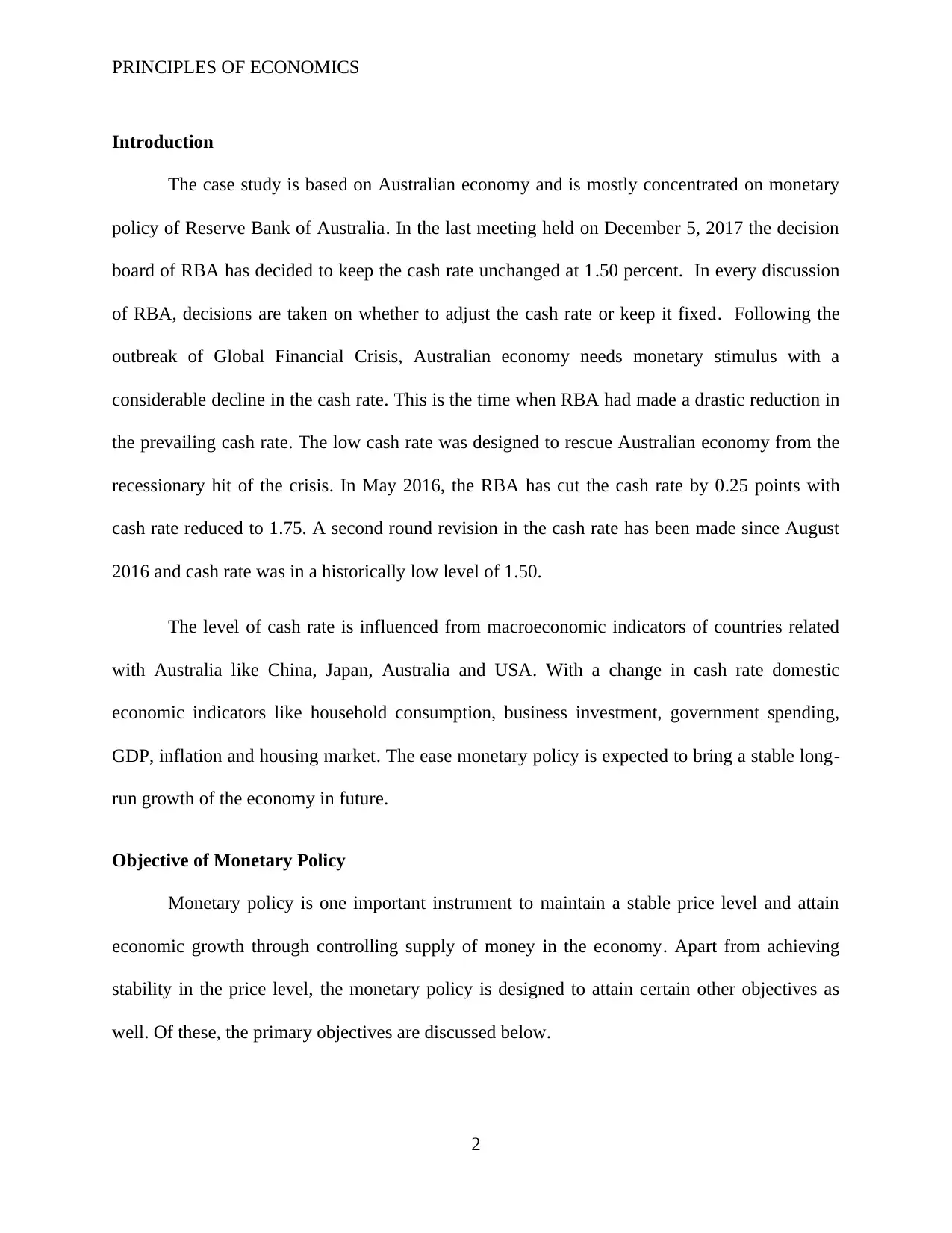
PRINCIPLES OF ECONOMICS
Introduction
The case study is based on Australian economy and is mostly concentrated on monetary
policy of Reserve Bank of Australia. In the last meeting held on December 5, 2017 the decision
board of RBA has decided to keep the cash rate unchanged at 1.50 percent. In every discussion
of RBA, decisions are taken on whether to adjust the cash rate or keep it fixed. Following the
outbreak of Global Financial Crisis, Australian economy needs monetary stimulus with a
considerable decline in the cash rate. This is the time when RBA had made a drastic reduction in
the prevailing cash rate. The low cash rate was designed to rescue Australian economy from the
recessionary hit of the crisis. In May 2016, the RBA has cut the cash rate by 0.25 points with
cash rate reduced to 1.75. A second round revision in the cash rate has been made since August
2016 and cash rate was in a historically low level of 1.50.
The level of cash rate is influenced from macroeconomic indicators of countries related
with Australia like China, Japan, Australia and USA. With a change in cash rate domestic
economic indicators like household consumption, business investment, government spending,
GDP, inflation and housing market. The ease monetary policy is expected to bring a stable long-
run growth of the economy in future.
Objective of Monetary Policy
Monetary policy is one important instrument to maintain a stable price level and attain
economic growth through controlling supply of money in the economy. Apart from achieving
stability in the price level, the monetary policy is designed to attain certain other objectives as
well. Of these, the primary objectives are discussed below.
2
Introduction
The case study is based on Australian economy and is mostly concentrated on monetary
policy of Reserve Bank of Australia. In the last meeting held on December 5, 2017 the decision
board of RBA has decided to keep the cash rate unchanged at 1.50 percent. In every discussion
of RBA, decisions are taken on whether to adjust the cash rate or keep it fixed. Following the
outbreak of Global Financial Crisis, Australian economy needs monetary stimulus with a
considerable decline in the cash rate. This is the time when RBA had made a drastic reduction in
the prevailing cash rate. The low cash rate was designed to rescue Australian economy from the
recessionary hit of the crisis. In May 2016, the RBA has cut the cash rate by 0.25 points with
cash rate reduced to 1.75. A second round revision in the cash rate has been made since August
2016 and cash rate was in a historically low level of 1.50.
The level of cash rate is influenced from macroeconomic indicators of countries related
with Australia like China, Japan, Australia and USA. With a change in cash rate domestic
economic indicators like household consumption, business investment, government spending,
GDP, inflation and housing market. The ease monetary policy is expected to bring a stable long-
run growth of the economy in future.
Objective of Monetary Policy
Monetary policy is one important instrument to maintain a stable price level and attain
economic growth through controlling supply of money in the economy. Apart from achieving
stability in the price level, the monetary policy is designed to attain certain other objectives as
well. Of these, the primary objectives are discussed below.
2
⊘ This is a preview!⊘
Do you want full access?
Subscribe today to unlock all pages.

Trusted by 1+ million students worldwide
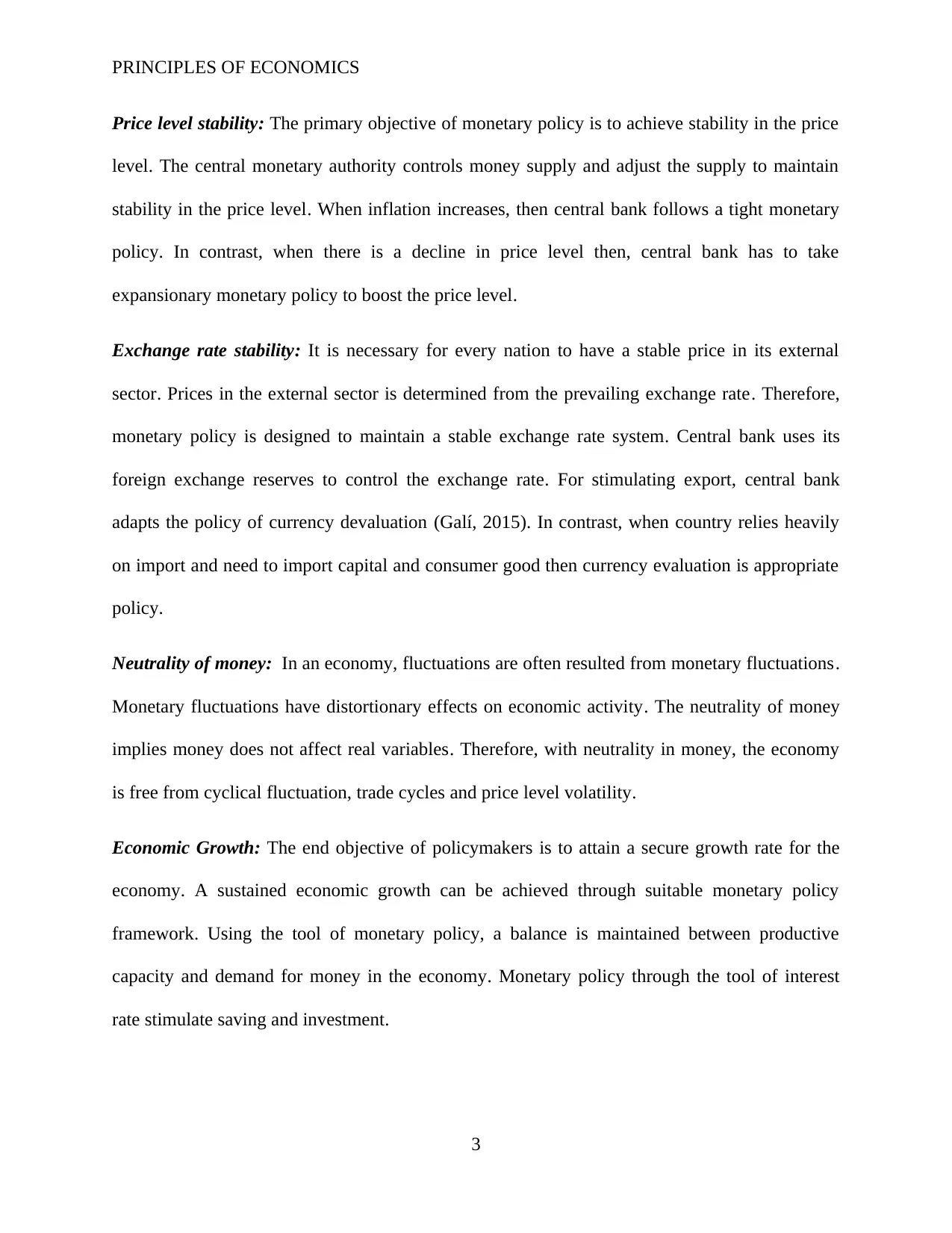
PRINCIPLES OF ECONOMICS
Price level stability: The primary objective of monetary policy is to achieve stability in the price
level. The central monetary authority controls money supply and adjust the supply to maintain
stability in the price level. When inflation increases, then central bank follows a tight monetary
policy. In contrast, when there is a decline in price level then, central bank has to take
expansionary monetary policy to boost the price level.
Exchange rate stability: It is necessary for every nation to have a stable price in its external
sector. Prices in the external sector is determined from the prevailing exchange rate. Therefore,
monetary policy is designed to maintain a stable exchange rate system. Central bank uses its
foreign exchange reserves to control the exchange rate. For stimulating export, central bank
adapts the policy of currency devaluation (Galí, 2015). In contrast, when country relies heavily
on import and need to import capital and consumer good then currency evaluation is appropriate
policy.
Neutrality of money: In an economy, fluctuations are often resulted from monetary fluctuations.
Monetary fluctuations have distortionary effects on economic activity. The neutrality of money
implies money does not affect real variables. Therefore, with neutrality in money, the economy
is free from cyclical fluctuation, trade cycles and price level volatility.
Economic Growth: The end objective of policymakers is to attain a secure growth rate for the
economy. A sustained economic growth can be achieved through suitable monetary policy
framework. Using the tool of monetary policy, a balance is maintained between productive
capacity and demand for money in the economy. Monetary policy through the tool of interest
rate stimulate saving and investment.
3
Price level stability: The primary objective of monetary policy is to achieve stability in the price
level. The central monetary authority controls money supply and adjust the supply to maintain
stability in the price level. When inflation increases, then central bank follows a tight monetary
policy. In contrast, when there is a decline in price level then, central bank has to take
expansionary monetary policy to boost the price level.
Exchange rate stability: It is necessary for every nation to have a stable price in its external
sector. Prices in the external sector is determined from the prevailing exchange rate. Therefore,
monetary policy is designed to maintain a stable exchange rate system. Central bank uses its
foreign exchange reserves to control the exchange rate. For stimulating export, central bank
adapts the policy of currency devaluation (Galí, 2015). In contrast, when country relies heavily
on import and need to import capital and consumer good then currency evaluation is appropriate
policy.
Neutrality of money: In an economy, fluctuations are often resulted from monetary fluctuations.
Monetary fluctuations have distortionary effects on economic activity. The neutrality of money
implies money does not affect real variables. Therefore, with neutrality in money, the economy
is free from cyclical fluctuation, trade cycles and price level volatility.
Economic Growth: The end objective of policymakers is to attain a secure growth rate for the
economy. A sustained economic growth can be achieved through suitable monetary policy
framework. Using the tool of monetary policy, a balance is maintained between productive
capacity and demand for money in the economy. Monetary policy through the tool of interest
rate stimulate saving and investment.
3
Paraphrase This Document
Need a fresh take? Get an instant paraphrase of this document with our AI Paraphraser
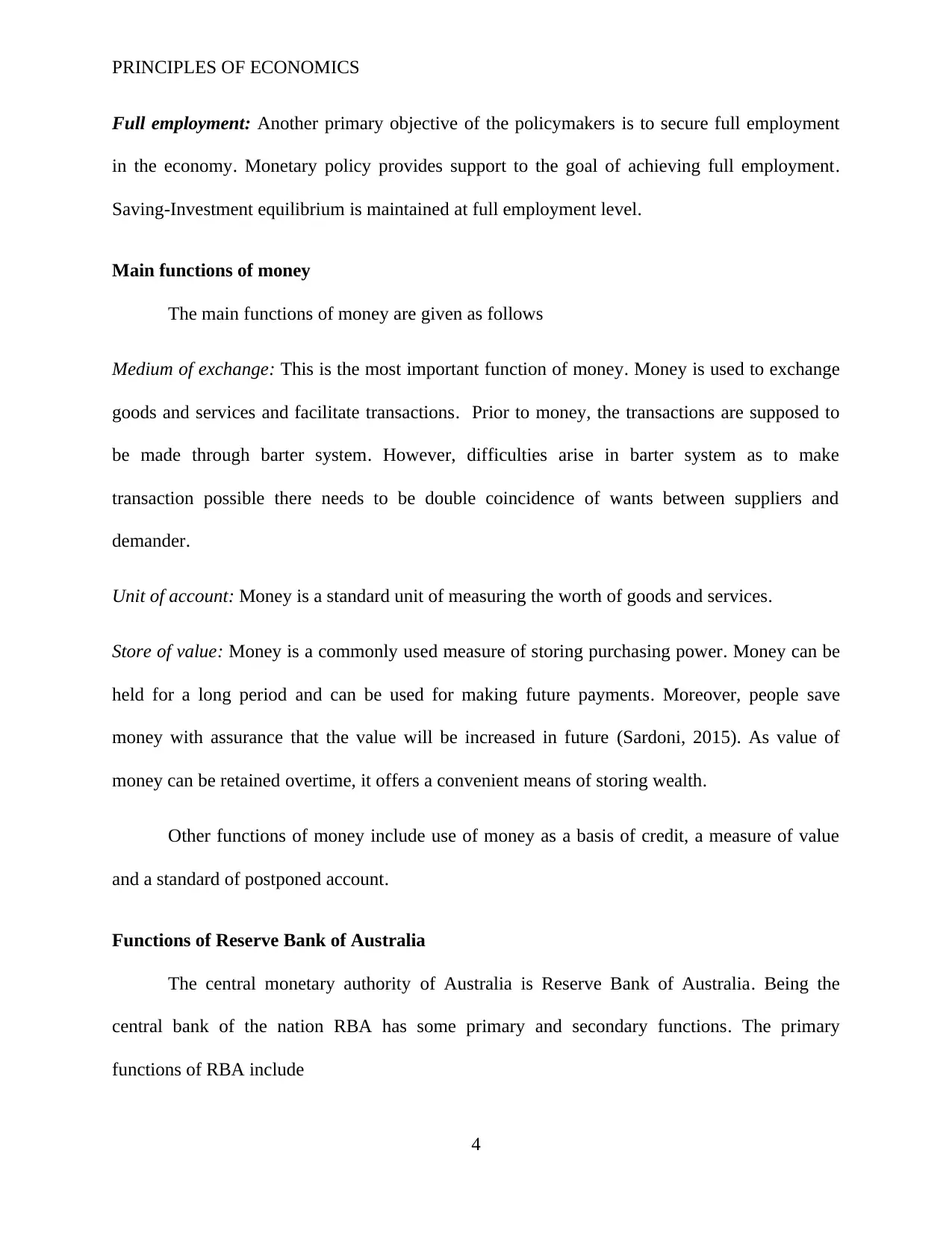
PRINCIPLES OF ECONOMICS
Full employment: Another primary objective of the policymakers is to secure full employment
in the economy. Monetary policy provides support to the goal of achieving full employment.
Saving-Investment equilibrium is maintained at full employment level.
Main functions of money
The main functions of money are given as follows
Medium of exchange: This is the most important function of money. Money is used to exchange
goods and services and facilitate transactions. Prior to money, the transactions are supposed to
be made through barter system. However, difficulties arise in barter system as to make
transaction possible there needs to be double coincidence of wants between suppliers and
demander.
Unit of account: Money is a standard unit of measuring the worth of goods and services.
Store of value: Money is a commonly used measure of storing purchasing power. Money can be
held for a long period and can be used for making future payments. Moreover, people save
money with assurance that the value will be increased in future (Sardoni, 2015). As value of
money can be retained overtime, it offers a convenient means of storing wealth.
Other functions of money include use of money as a basis of credit, a measure of value
and a standard of postponed account.
Functions of Reserve Bank of Australia
The central monetary authority of Australia is Reserve Bank of Australia. Being the
central bank of the nation RBA has some primary and secondary functions. The primary
functions of RBA include
4
Full employment: Another primary objective of the policymakers is to secure full employment
in the economy. Monetary policy provides support to the goal of achieving full employment.
Saving-Investment equilibrium is maintained at full employment level.
Main functions of money
The main functions of money are given as follows
Medium of exchange: This is the most important function of money. Money is used to exchange
goods and services and facilitate transactions. Prior to money, the transactions are supposed to
be made through barter system. However, difficulties arise in barter system as to make
transaction possible there needs to be double coincidence of wants between suppliers and
demander.
Unit of account: Money is a standard unit of measuring the worth of goods and services.
Store of value: Money is a commonly used measure of storing purchasing power. Money can be
held for a long period and can be used for making future payments. Moreover, people save
money with assurance that the value will be increased in future (Sardoni, 2015). As value of
money can be retained overtime, it offers a convenient means of storing wealth.
Other functions of money include use of money as a basis of credit, a measure of value
and a standard of postponed account.
Functions of Reserve Bank of Australia
The central monetary authority of Australia is Reserve Bank of Australia. Being the
central bank of the nation RBA has some primary and secondary functions. The primary
functions of RBA include
4
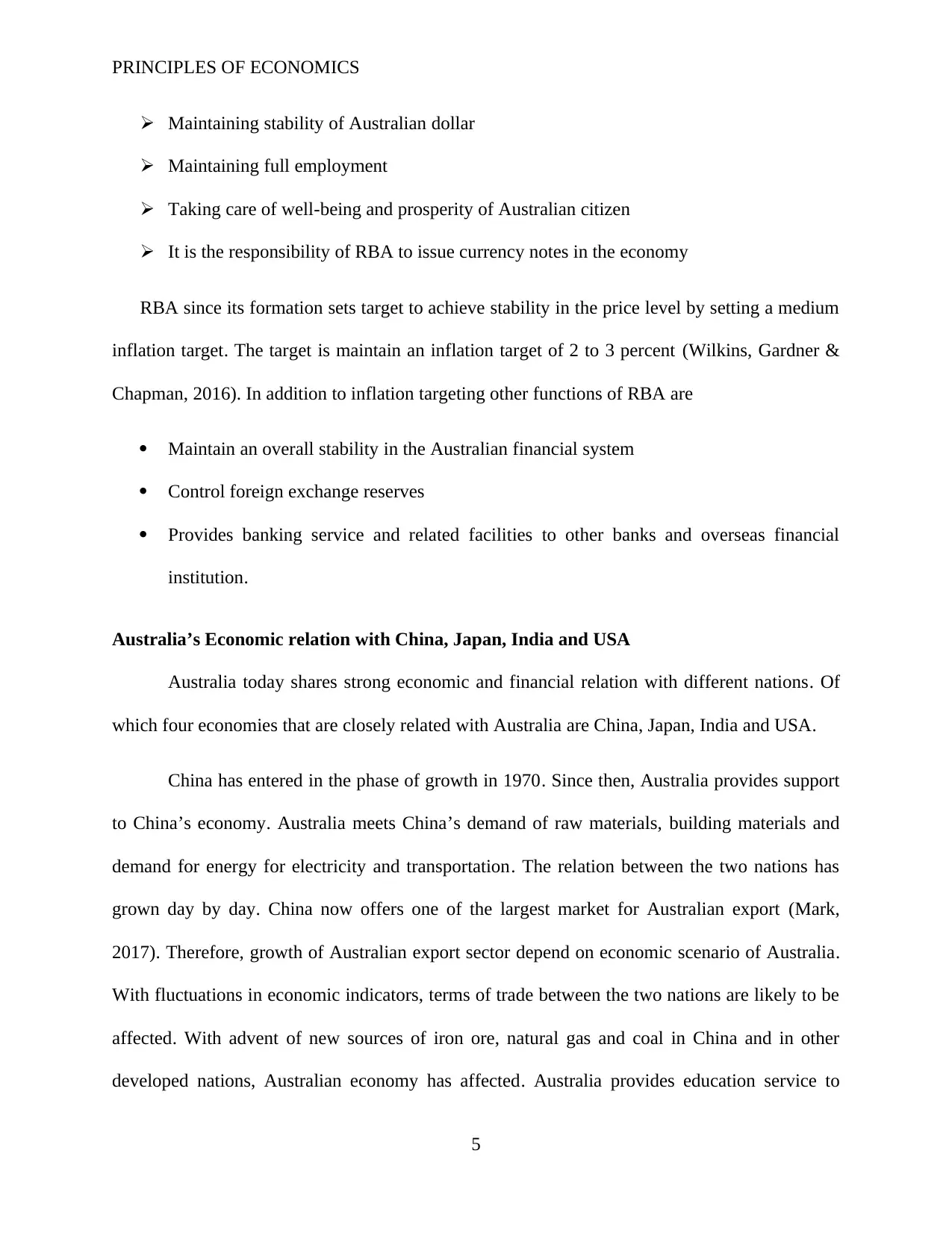
PRINCIPLES OF ECONOMICS
Maintaining stability of Australian dollar
Maintaining full employment
Taking care of well-being and prosperity of Australian citizen
It is the responsibility of RBA to issue currency notes in the economy
RBA since its formation sets target to achieve stability in the price level by setting a medium
inflation target. The target is maintain an inflation target of 2 to 3 percent (Wilkins, Gardner &
Chapman, 2016). In addition to inflation targeting other functions of RBA are
Maintain an overall stability in the Australian financial system
Control foreign exchange reserves
Provides banking service and related facilities to other banks and overseas financial
institution.
Australia’s Economic relation with China, Japan, India and USA
Australia today shares strong economic and financial relation with different nations. Of
which four economies that are closely related with Australia are China, Japan, India and USA.
China has entered in the phase of growth in 1970. Since then, Australia provides support
to China’s economy. Australia meets China’s demand of raw materials, building materials and
demand for energy for electricity and transportation. The relation between the two nations has
grown day by day. China now offers one of the largest market for Australian export (Mark,
2017). Therefore, growth of Australian export sector depend on economic scenario of Australia.
With fluctuations in economic indicators, terms of trade between the two nations are likely to be
affected. With advent of new sources of iron ore, natural gas and coal in China and in other
developed nations, Australian economy has affected. Australia provides education service to
5
Maintaining stability of Australian dollar
Maintaining full employment
Taking care of well-being and prosperity of Australian citizen
It is the responsibility of RBA to issue currency notes in the economy
RBA since its formation sets target to achieve stability in the price level by setting a medium
inflation target. The target is maintain an inflation target of 2 to 3 percent (Wilkins, Gardner &
Chapman, 2016). In addition to inflation targeting other functions of RBA are
Maintain an overall stability in the Australian financial system
Control foreign exchange reserves
Provides banking service and related facilities to other banks and overseas financial
institution.
Australia’s Economic relation with China, Japan, India and USA
Australia today shares strong economic and financial relation with different nations. Of
which four economies that are closely related with Australia are China, Japan, India and USA.
China has entered in the phase of growth in 1970. Since then, Australia provides support
to China’s economy. Australia meets China’s demand of raw materials, building materials and
demand for energy for electricity and transportation. The relation between the two nations has
grown day by day. China now offers one of the largest market for Australian export (Mark,
2017). Therefore, growth of Australian export sector depend on economic scenario of Australia.
With fluctuations in economic indicators, terms of trade between the two nations are likely to be
affected. With advent of new sources of iron ore, natural gas and coal in China and in other
developed nations, Australian economy has affected. Australia provides education service to
5
⊘ This is a preview!⊘
Do you want full access?
Subscribe today to unlock all pages.

Trusted by 1+ million students worldwide
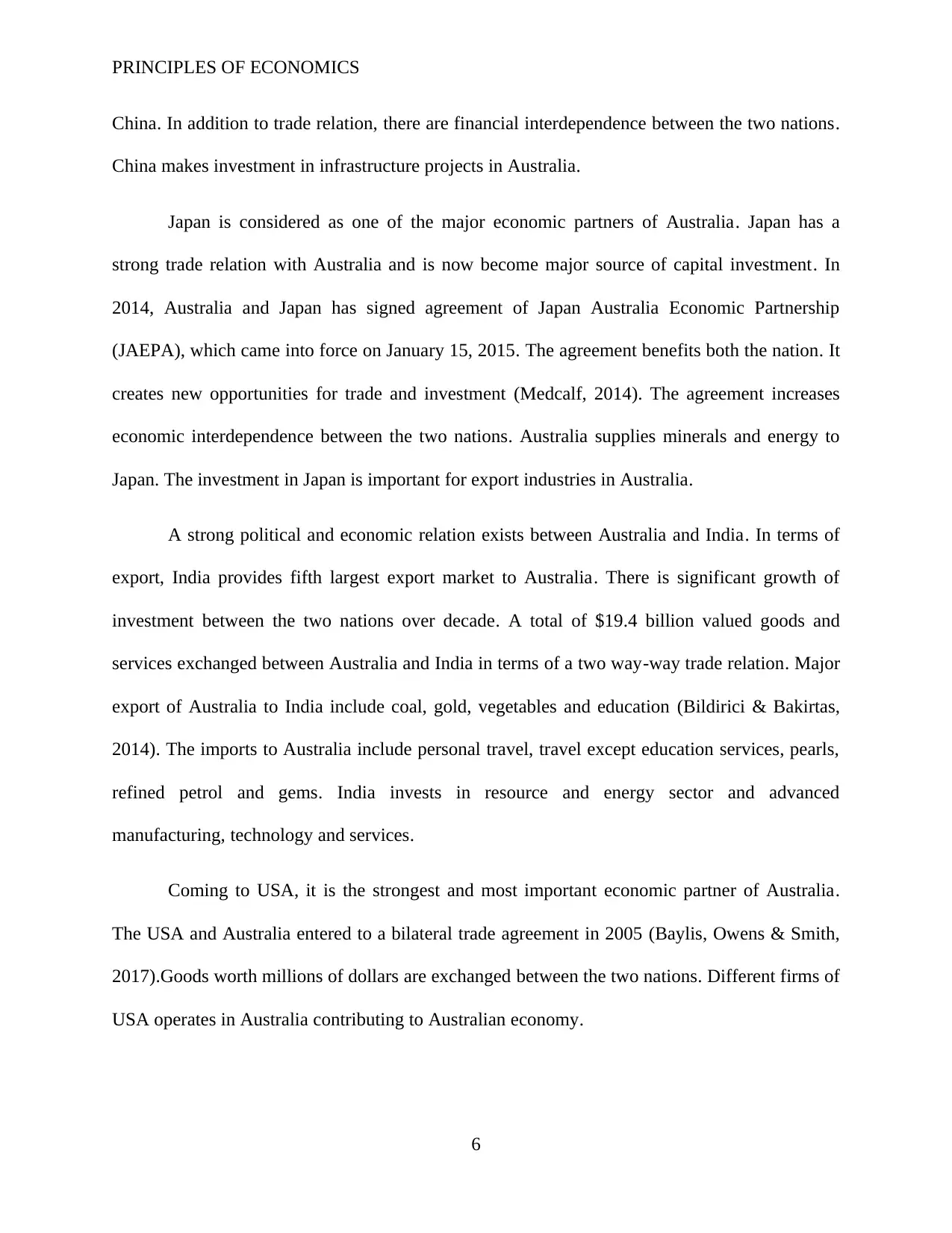
PRINCIPLES OF ECONOMICS
China. In addition to trade relation, there are financial interdependence between the two nations.
China makes investment in infrastructure projects in Australia.
Japan is considered as one of the major economic partners of Australia. Japan has a
strong trade relation with Australia and is now become major source of capital investment. In
2014, Australia and Japan has signed agreement of Japan Australia Economic Partnership
(JAEPA), which came into force on January 15, 2015. The agreement benefits both the nation. It
creates new opportunities for trade and investment (Medcalf, 2014). The agreement increases
economic interdependence between the two nations. Australia supplies minerals and energy to
Japan. The investment in Japan is important for export industries in Australia.
A strong political and economic relation exists between Australia and India. In terms of
export, India provides fifth largest export market to Australia. There is significant growth of
investment between the two nations over decade. A total of $19.4 billion valued goods and
services exchanged between Australia and India in terms of a two way-way trade relation. Major
export of Australia to India include coal, gold, vegetables and education (Bildirici & Bakirtas,
2014). The imports to Australia include personal travel, travel except education services, pearls,
refined petrol and gems. India invests in resource and energy sector and advanced
manufacturing, technology and services.
Coming to USA, it is the strongest and most important economic partner of Australia.
The USA and Australia entered to a bilateral trade agreement in 2005 (Baylis, Owens & Smith,
2017).Goods worth millions of dollars are exchanged between the two nations. Different firms of
USA operates in Australia contributing to Australian economy.
6
China. In addition to trade relation, there are financial interdependence between the two nations.
China makes investment in infrastructure projects in Australia.
Japan is considered as one of the major economic partners of Australia. Japan has a
strong trade relation with Australia and is now become major source of capital investment. In
2014, Australia and Japan has signed agreement of Japan Australia Economic Partnership
(JAEPA), which came into force on January 15, 2015. The agreement benefits both the nation. It
creates new opportunities for trade and investment (Medcalf, 2014). The agreement increases
economic interdependence between the two nations. Australia supplies minerals and energy to
Japan. The investment in Japan is important for export industries in Australia.
A strong political and economic relation exists between Australia and India. In terms of
export, India provides fifth largest export market to Australia. There is significant growth of
investment between the two nations over decade. A total of $19.4 billion valued goods and
services exchanged between Australia and India in terms of a two way-way trade relation. Major
export of Australia to India include coal, gold, vegetables and education (Bildirici & Bakirtas,
2014). The imports to Australia include personal travel, travel except education services, pearls,
refined petrol and gems. India invests in resource and energy sector and advanced
manufacturing, technology and services.
Coming to USA, it is the strongest and most important economic partner of Australia.
The USA and Australia entered to a bilateral trade agreement in 2005 (Baylis, Owens & Smith,
2017).Goods worth millions of dollars are exchanged between the two nations. Different firms of
USA operates in Australia contributing to Australian economy.
6
Paraphrase This Document
Need a fresh take? Get an instant paraphrase of this document with our AI Paraphraser
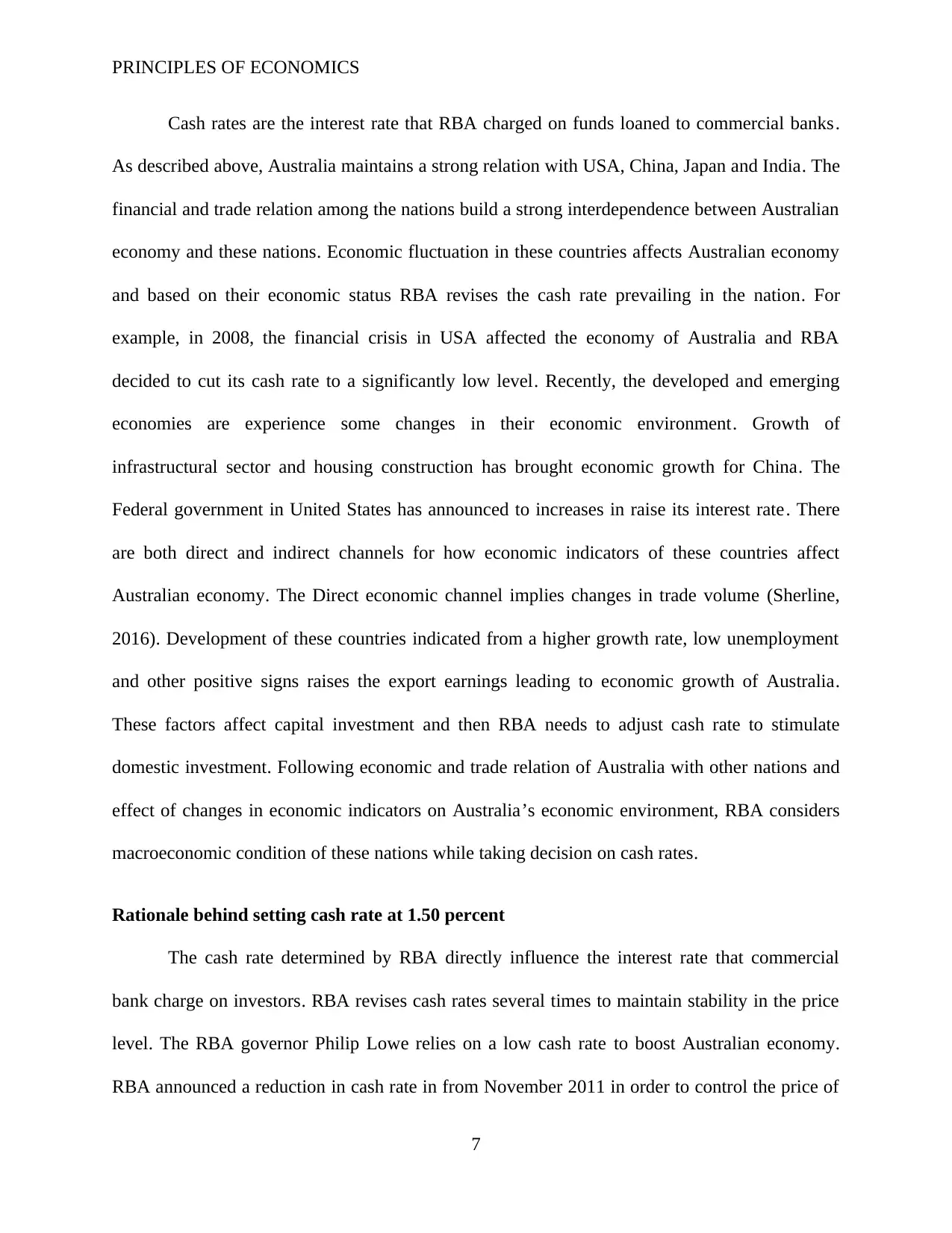
PRINCIPLES OF ECONOMICS
Cash rates are the interest rate that RBA charged on funds loaned to commercial banks.
As described above, Australia maintains a strong relation with USA, China, Japan and India. The
financial and trade relation among the nations build a strong interdependence between Australian
economy and these nations. Economic fluctuation in these countries affects Australian economy
and based on their economic status RBA revises the cash rate prevailing in the nation. For
example, in 2008, the financial crisis in USA affected the economy of Australia and RBA
decided to cut its cash rate to a significantly low level. Recently, the developed and emerging
economies are experience some changes in their economic environment. Growth of
infrastructural sector and housing construction has brought economic growth for China. The
Federal government in United States has announced to increases in raise its interest rate. There
are both direct and indirect channels for how economic indicators of these countries affect
Australian economy. The Direct economic channel implies changes in trade volume (Sherline,
2016). Development of these countries indicated from a higher growth rate, low unemployment
and other positive signs raises the export earnings leading to economic growth of Australia.
These factors affect capital investment and then RBA needs to adjust cash rate to stimulate
domestic investment. Following economic and trade relation of Australia with other nations and
effect of changes in economic indicators on Australia’s economic environment, RBA considers
macroeconomic condition of these nations while taking decision on cash rates.
Rationale behind setting cash rate at 1.50 percent
The cash rate determined by RBA directly influence the interest rate that commercial
bank charge on investors. RBA revises cash rates several times to maintain stability in the price
level. The RBA governor Philip Lowe relies on a low cash rate to boost Australian economy.
RBA announced a reduction in cash rate in from November 2011 in order to control the price of
7
Cash rates are the interest rate that RBA charged on funds loaned to commercial banks.
As described above, Australia maintains a strong relation with USA, China, Japan and India. The
financial and trade relation among the nations build a strong interdependence between Australian
economy and these nations. Economic fluctuation in these countries affects Australian economy
and based on their economic status RBA revises the cash rate prevailing in the nation. For
example, in 2008, the financial crisis in USA affected the economy of Australia and RBA
decided to cut its cash rate to a significantly low level. Recently, the developed and emerging
economies are experience some changes in their economic environment. Growth of
infrastructural sector and housing construction has brought economic growth for China. The
Federal government in United States has announced to increases in raise its interest rate. There
are both direct and indirect channels for how economic indicators of these countries affect
Australian economy. The Direct economic channel implies changes in trade volume (Sherline,
2016). Development of these countries indicated from a higher growth rate, low unemployment
and other positive signs raises the export earnings leading to economic growth of Australia.
These factors affect capital investment and then RBA needs to adjust cash rate to stimulate
domestic investment. Following economic and trade relation of Australia with other nations and
effect of changes in economic indicators on Australia’s economic environment, RBA considers
macroeconomic condition of these nations while taking decision on cash rates.
Rationale behind setting cash rate at 1.50 percent
The cash rate determined by RBA directly influence the interest rate that commercial
bank charge on investors. RBA revises cash rates several times to maintain stability in the price
level. The RBA governor Philip Lowe relies on a low cash rate to boost Australian economy.
RBA announced a reduction in cash rate in from November 2011 in order to control the price of
7
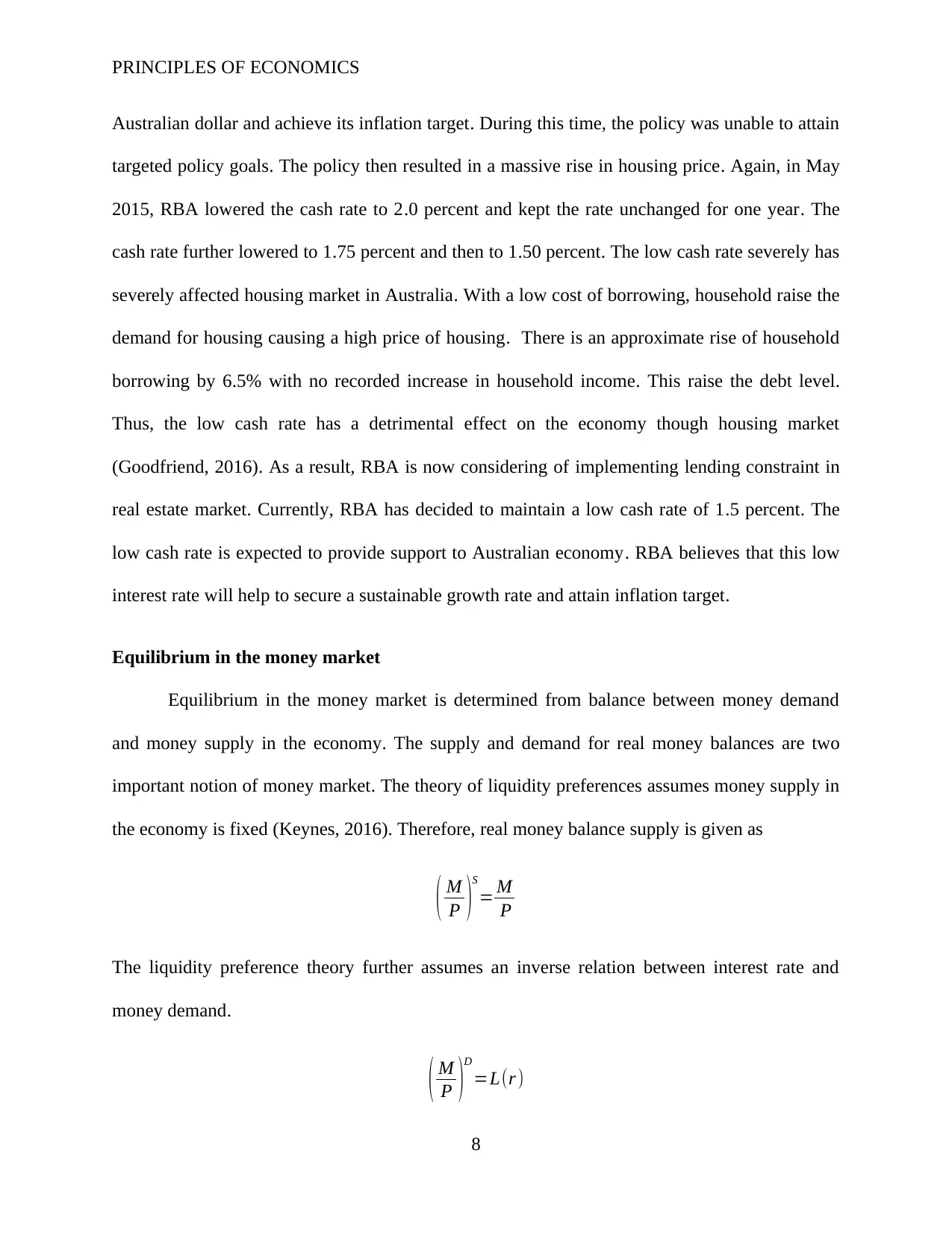
PRINCIPLES OF ECONOMICS
Australian dollar and achieve its inflation target. During this time, the policy was unable to attain
targeted policy goals. The policy then resulted in a massive rise in housing price. Again, in May
2015, RBA lowered the cash rate to 2.0 percent and kept the rate unchanged for one year. The
cash rate further lowered to 1.75 percent and then to 1.50 percent. The low cash rate severely has
severely affected housing market in Australia. With a low cost of borrowing, household raise the
demand for housing causing a high price of housing. There is an approximate rise of household
borrowing by 6.5% with no recorded increase in household income. This raise the debt level.
Thus, the low cash rate has a detrimental effect on the economy though housing market
(Goodfriend, 2016). As a result, RBA is now considering of implementing lending constraint in
real estate market. Currently, RBA has decided to maintain a low cash rate of 1.5 percent. The
low cash rate is expected to provide support to Australian economy. RBA believes that this low
interest rate will help to secure a sustainable growth rate and attain inflation target.
Equilibrium in the money market
Equilibrium in the money market is determined from balance between money demand
and money supply in the economy. The supply and demand for real money balances are two
important notion of money market. The theory of liquidity preferences assumes money supply in
the economy is fixed (Keynes, 2016). Therefore, real money balance supply is given as
( M
P )
S
= M
P
The liquidity preference theory further assumes an inverse relation between interest rate and
money demand.
( M
P )D
=L(r )
8
Australian dollar and achieve its inflation target. During this time, the policy was unable to attain
targeted policy goals. The policy then resulted in a massive rise in housing price. Again, in May
2015, RBA lowered the cash rate to 2.0 percent and kept the rate unchanged for one year. The
cash rate further lowered to 1.75 percent and then to 1.50 percent. The low cash rate severely has
severely affected housing market in Australia. With a low cost of borrowing, household raise the
demand for housing causing a high price of housing. There is an approximate rise of household
borrowing by 6.5% with no recorded increase in household income. This raise the debt level.
Thus, the low cash rate has a detrimental effect on the economy though housing market
(Goodfriend, 2016). As a result, RBA is now considering of implementing lending constraint in
real estate market. Currently, RBA has decided to maintain a low cash rate of 1.5 percent. The
low cash rate is expected to provide support to Australian economy. RBA believes that this low
interest rate will help to secure a sustainable growth rate and attain inflation target.
Equilibrium in the money market
Equilibrium in the money market is determined from balance between money demand
and money supply in the economy. The supply and demand for real money balances are two
important notion of money market. The theory of liquidity preferences assumes money supply in
the economy is fixed (Keynes, 2016). Therefore, real money balance supply is given as
( M
P )
S
= M
P
The liquidity preference theory further assumes an inverse relation between interest rate and
money demand.
( M
P )D
=L(r )
8
⊘ This is a preview!⊘
Do you want full access?
Subscribe today to unlock all pages.

Trusted by 1+ million students worldwide
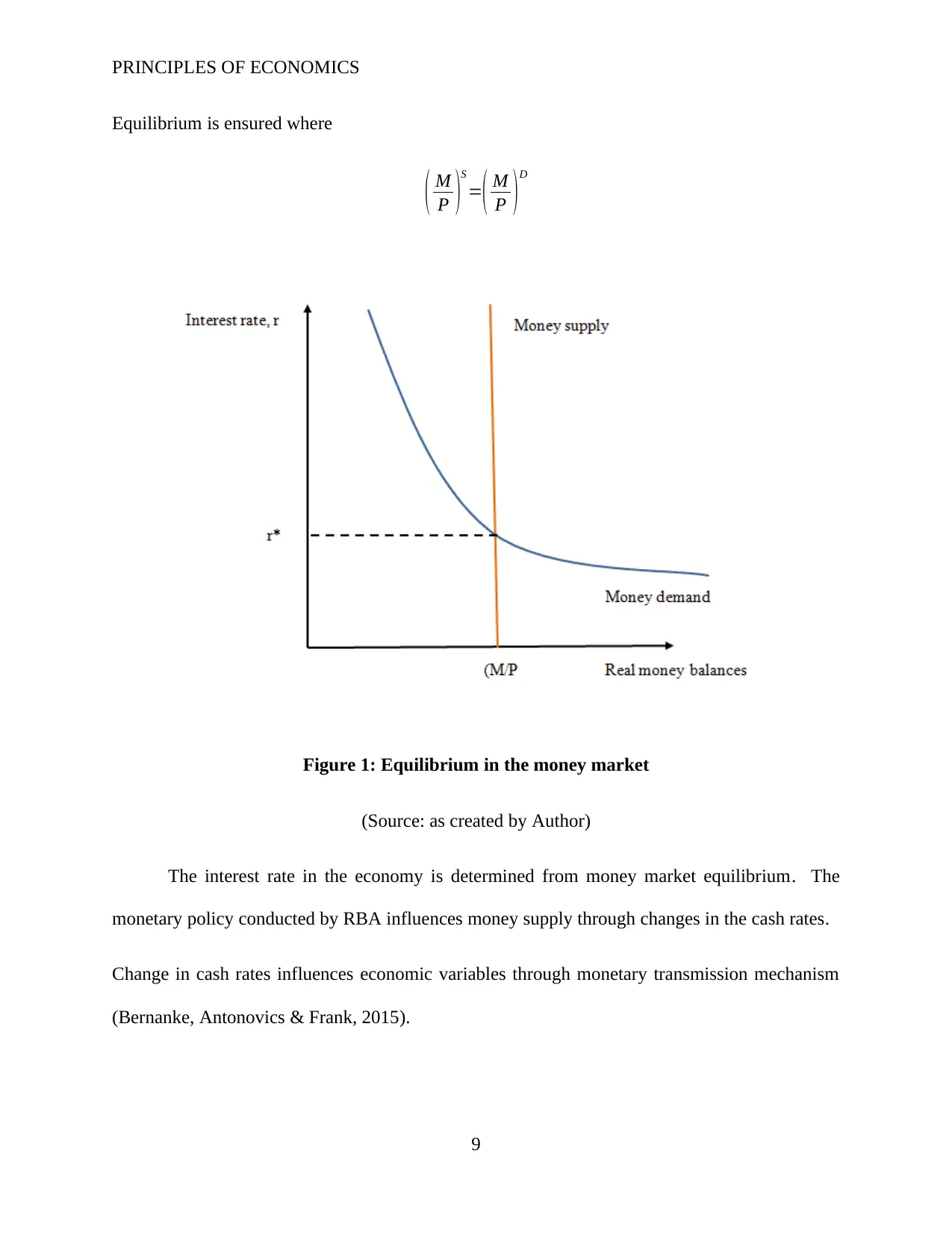
PRINCIPLES OF ECONOMICS
Equilibrium is ensured where
( M
P )
S
=( M
P ) D
Figure 1: Equilibrium in the money market
(Source: as created by Author)
The interest rate in the economy is determined from money market equilibrium. The
monetary policy conducted by RBA influences money supply through changes in the cash rates.
Change in cash rates influences economic variables through monetary transmission mechanism
(Bernanke, Antonovics & Frank, 2015).
9
Equilibrium is ensured where
( M
P )
S
=( M
P ) D
Figure 1: Equilibrium in the money market
(Source: as created by Author)
The interest rate in the economy is determined from money market equilibrium. The
monetary policy conducted by RBA influences money supply through changes in the cash rates.
Change in cash rates influences economic variables through monetary transmission mechanism
(Bernanke, Antonovics & Frank, 2015).
9
Paraphrase This Document
Need a fresh take? Get an instant paraphrase of this document with our AI Paraphraser
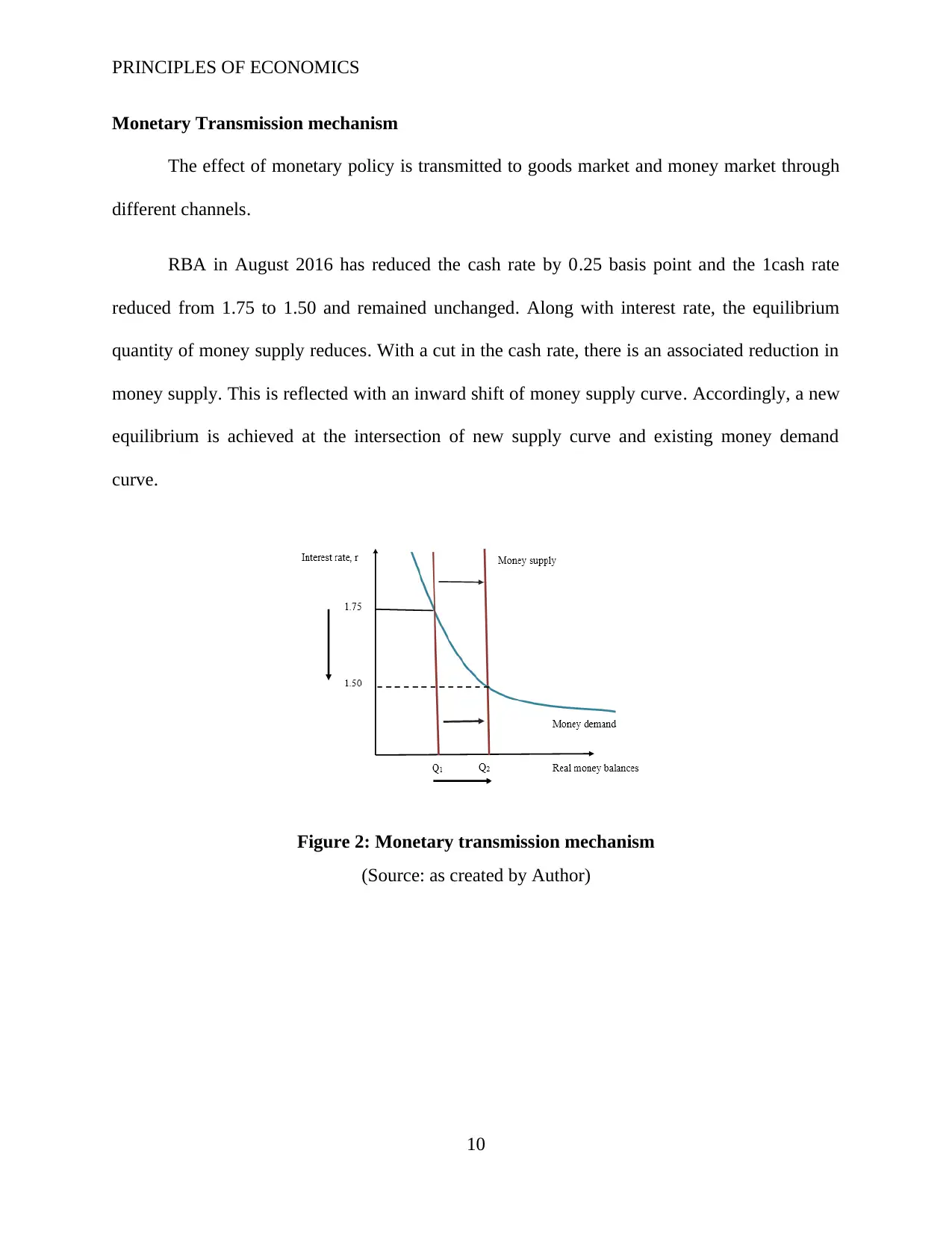
PRINCIPLES OF ECONOMICS
Monetary Transmission mechanism
The effect of monetary policy is transmitted to goods market and money market through
different channels.
RBA in August 2016 has reduced the cash rate by 0.25 basis point and the 1cash rate
reduced from 1.75 to 1.50 and remained unchanged. Along with interest rate, the equilibrium
quantity of money supply reduces. With a cut in the cash rate, there is an associated reduction in
money supply. This is reflected with an inward shift of money supply curve. Accordingly, a new
equilibrium is achieved at the intersection of new supply curve and existing money demand
curve.
Figure 2: Monetary transmission mechanism
(Source: as created by Author)
10
Monetary Transmission mechanism
The effect of monetary policy is transmitted to goods market and money market through
different channels.
RBA in August 2016 has reduced the cash rate by 0.25 basis point and the 1cash rate
reduced from 1.75 to 1.50 and remained unchanged. Along with interest rate, the equilibrium
quantity of money supply reduces. With a cut in the cash rate, there is an associated reduction in
money supply. This is reflected with an inward shift of money supply curve. Accordingly, a new
equilibrium is achieved at the intersection of new supply curve and existing money demand
curve.
Figure 2: Monetary transmission mechanism
(Source: as created by Author)
10
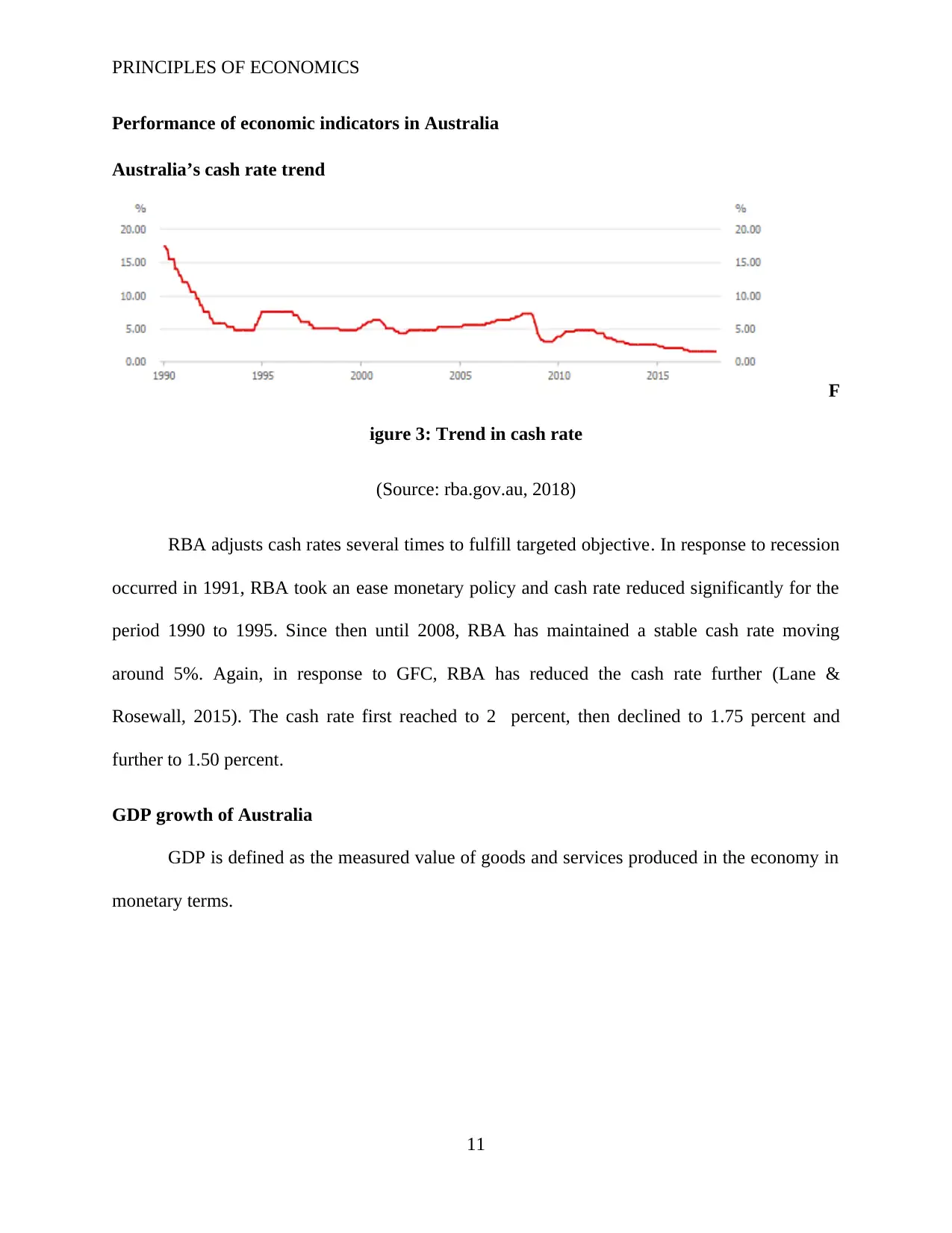
PRINCIPLES OF ECONOMICS
Performance of economic indicators in Australia
Australia’s cash rate trend
F
igure 3: Trend in cash rate
(Source: rba.gov.au, 2018)
RBA adjusts cash rates several times to fulfill targeted objective. In response to recession
occurred in 1991, RBA took an ease monetary policy and cash rate reduced significantly for the
period 1990 to 1995. Since then until 2008, RBA has maintained a stable cash rate moving
around 5%. Again, in response to GFC, RBA has reduced the cash rate further (Lane &
Rosewall, 2015). The cash rate first reached to 2 percent, then declined to 1.75 percent and
further to 1.50 percent.
GDP growth of Australia
GDP is defined as the measured value of goods and services produced in the economy in
monetary terms.
11
Performance of economic indicators in Australia
Australia’s cash rate trend
F
igure 3: Trend in cash rate
(Source: rba.gov.au, 2018)
RBA adjusts cash rates several times to fulfill targeted objective. In response to recession
occurred in 1991, RBA took an ease monetary policy and cash rate reduced significantly for the
period 1990 to 1995. Since then until 2008, RBA has maintained a stable cash rate moving
around 5%. Again, in response to GFC, RBA has reduced the cash rate further (Lane &
Rosewall, 2015). The cash rate first reached to 2 percent, then declined to 1.75 percent and
further to 1.50 percent.
GDP growth of Australia
GDP is defined as the measured value of goods and services produced in the economy in
monetary terms.
11
⊘ This is a preview!⊘
Do you want full access?
Subscribe today to unlock all pages.

Trusted by 1+ million students worldwide
1 out of 22
Related Documents
Your All-in-One AI-Powered Toolkit for Academic Success.
+13062052269
info@desklib.com
Available 24*7 on WhatsApp / Email
![[object Object]](/_next/static/media/star-bottom.7253800d.svg)
Unlock your academic potential
Copyright © 2020–2025 A2Z Services. All Rights Reserved. Developed and managed by ZUCOL.




